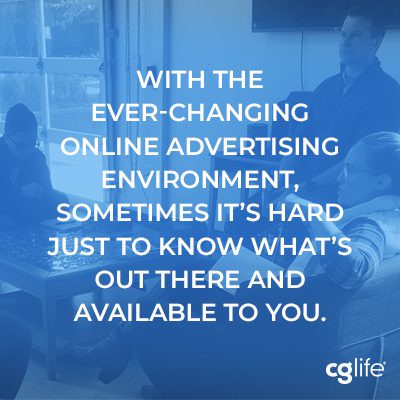It’s Q4 2018, and in my experience, that means a mad dash to the finish trying to finalize paid media plans and secure advertising inventory for the coming year. It can be a daunting task even with an experienced agency behind you. To get ahead of the game, here are some tips and tricks to make the most of your 2019 advertising plans.
Paid media: Start with the end in mind
As cheesy as it sounds, goal setting is critical to measuring the success of any ad campaign. What are you trying to accomplish? If you’re primarily concerned with generating awareness, is impression volume a sufficient metric for your business to measure success? If it’s not, how will you define a conversion? Is a lead-gen form enough, or do you have to worry about your ecommerce environment tying into your CRM? This goal setting goes beyond just “what success looks like”; also consider the end-user experience for your campaign. Where are you driving people? What are you asking them to do when they get there? Do you have a valuable enough piece of content to motivate your audience to share their information? If you could be a fly on the wall in a media planning intake session with us, you’ll hear us fire off these questions first thing because your entire media plan will cascade out of this discussion.
Set a comfortable budget for paid advertising
Consider your business objectives from the goal-setting discussion and decide how much it’s worth to your business—i.e., clearly define your paid advertising budget. Agencies are a great resource to help set realistic expectations for media spend simply because we know how much inventory costs, but ultimately, you know your business better than we do. You know your annual revenue targets, your overhead, your customer lifetime value, and you know, far better than us, how much a lead is worth to your business.
Establish selection criteria: channels, assets and targeting
With a goal and budget, you can come up with a solid plan. The next step in the process is channel and vendor selection. With the ever-changing online advertising environment, sometimes it’s hard just to know what’s out there and available to you. New opportunities, technologies or ad formats pop up all the time. Don’t be overwhelmed; start with the basics and map back to your goals to choose the channels and vendors within your budget. Start with the most important question: who are you trying to reach? If you have clearly outlined buyer personas, provide those to your media planning agency. And continue to ask key questions as your selection criteria. What does their consideration process look like prior to purchasing? Where do they evaluate potential solutions? When in doubt, ask your customers! They can tell you what industry publications they read, where they spend time online, and what marketing materials appeal most to them. Considering any production limitations your marketing team may encounter and what assets will be available to fuel your campaign will help you narrow down your channel selections. Are you creating banner ads? Animated or static? Gif or HTML5? Do you have a print concept? Do you have video content that could be repurposed into video ads? Also consider who will be writing paid social, paid search or native text ads as you’ll want to think this through before you find yourself with 1,000 ad variations required to fulfill your media plan.
Considering any production limitations your marketing team may encounter and what assets will be available to fuel your campaign will help you narrow down your channel selections. Are you creating banner ads? Animated or static? Gif or HTML5? Do you have a print concept? Do you have video content that could be repurposed into video ads? Also consider who will be writing paid social, paid search or native text ads as you’ll want to think this through before you find yourself with 1,000 ad variations required to fulfill your media plan.
Cross-channel marketing vendor selection
Now that you have worked through your strategy, you will need to evaluate your cross-channel marketing vendors. When it comes to partnering with traditional publishers, they can provide circulation data that will aid you in the selection process. Some even offer BPA (Business Publications Audit) statements along with their media kits—an unbiased verification of their circulation claims. Look for the vendors that have the broadest reach with your specific audience. Most will have content marketing options suitable for lead-gen goals (think: webinars & e-books available for download) as well as print and digital options to promote awareness among their readership. In the world of B2B scientific and medical marketing, it’s important to maintain a presence with industry publications for sheer brand perception: be where your audience consumes valuable, relevant content. Budget permitting, we recommend your media mix includes a variety of channels and vendors. Omni-channel ad strategies maximize the impact of your message by reaching your audience with multiple touchpoints throughout their day, reinforcing their relationship with your brand and preventing ad fatigue.
Paid media best practices
To recap, it’s always best to have a plan and a process before you launch any advertising campaign. The basic process you should follow includes:
- Goal setting: Set criteria to measure success—for you and your customers (the end-users)
- Budget: Establish realistic expectations for media spend
- Channel selection: what ad formats make the most sense for your campaign?
- Vendors and publishing partners: consider where your audience consumes content
Going through this process is a good idea not only for your 2019 paid media strategy but is a best practice before launching any campaign. Still need ideas? Contact us and we can help you build out the essential parts of your paid media campaigns for the best results. And read this related blog post on defining core marketing messaging.
